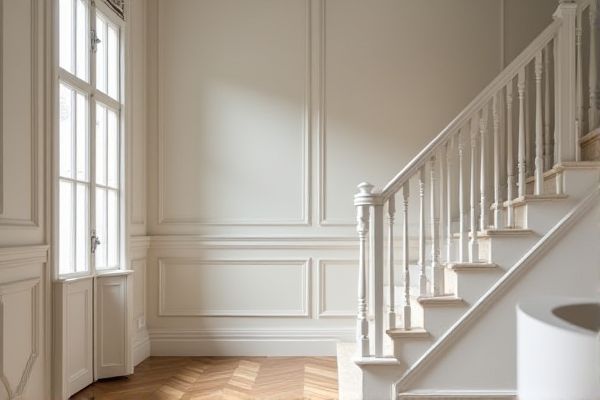
Traditional banisters often feature ornate designs and robust materials, adding classic elegance and a sense of craftsmanship to your staircase, while minimalist handrails emphasize clean lines, simplicity, and modern aesthetics, enhancing open spaces with unobtrusive functionality. Explore the rest of the article to discover which style best complements your home and lifestyle.
Table of Comparison
| Feature | Traditional Banister | Minimalist Handrail |
|---|---|---|
| Design Style | Ornate, detailed, classic | Sleek, simple, modern |
| Material | Wood, wrought iron, brass | Steel, glass, aluminum |
| Visual Impact | Bold statement, decorative | Subtle, blends with space |
| Maintenance | Requires regular polishing and upkeep | Low maintenance, easy to clean |
| Installation | Complex, labor-intensive | Simple, efficient |
| Cost | Higher due to craftsmanship | Generally lower, cost-effective |
| Safety | Sturdy, provides full support | Secure but less bulky |
Introduction to Staircase Safety and Design
Traditional banisters provide robust support and classic aesthetic appeal, featuring ornate balusters and sturdy newel posts that enhance staircase safety. Minimalist handrails emphasize sleek lines and simplicity, using slim profiles and materials like metal or wood to maintain safety while creating open, modern spaces. Both designs must meet building codes for height, grip, and load capacity to ensure optimal protection against falls.
Defining Traditional Banisters
Traditional banisters feature ornate designs, often crafted from wood or wrought iron, emphasizing intricate detailing and classic aesthetics. Their robust structure and decorative elements provide a sense of elegance and historical charm, contrasting sharply with minimalist handrails' sleek and simple appearance. Choosing a traditional banister can enhance the classic ambiance of Your home's interior while serving as a functional and visually striking support.
What are Minimalist Handrails?
Minimalist handrails are sleek, modern railings characterized by clean lines and simplicity, often made from materials such as stainless steel, glass, or aluminum to create an unobtrusive aesthetic. Unlike traditional banisters, which feature ornate details and bulky structures, minimalist handrails emphasize functionality while maintaining a lightweight and open appearance. These designs enhance contemporary interiors by maximizing light flow and spatial perception without compromising safety or support.
Historical Evolution of Staircase Railings
Traditional banisters, characterized by ornate balusters and intricate wood or metalwork, trace their historical evolution back to Renaissance and Victorian architecture, emphasizing craftsmanship and decorative detail. Minimalist handrails, emerging prominently in the mid-20th century with modernist and contemporary design movements, prioritize clean lines, functional materials like stainless steel or glass, and a sleek, unobtrusive aesthetic. The shift reflects broader architectural trends towards simplicity, transparency, and the integration of space and light in interior design.
Material Choices: Classic vs Contemporary
Traditional banisters often feature rich hardwoods like oak or mahogany, complemented by ornate wrought iron or brass accents that evoke timeless elegance. Minimalist handrails prioritize sleek materials such as stainless steel, glass, or aluminum, emphasizing clean lines and a modern aesthetic. Your choice between classic wood and metal or contemporary materials will significantly impact the overall style and ambiance of your staircase design.
Aesthetic Appeal: Ornate vs Clean Lines
Traditional banisters feature intricate carvings and ornate details that create a rich, classic aesthetic, appealing to those who appreciate historical charm and craftsmanship. Minimalist handrails emphasize clean lines and simplicity, offering a sleek, modern look that complements contemporary interior design. Your choice between these styles will significantly influence the visual impact and atmosphere of your space.
Installation and Maintenance Considerations
Traditional banisters typically require more time and expertise during installation due to their intricate designs and heavier materials like wood or wrought iron, which also demand periodic refinishing or painting to maintain their appearance. Minimalist handrails, often made from sleek materials such as stainless steel or glass, offer a quicker installation process with fewer components and generally require less maintenance, primarily involving simple cleaning to preserve their modern look. Your choice impacts long-term upkeep and installation costs, especially in high-traffic areas where durability and ease of cleaning are essential.
Cost Comparison: Which is More Budget-Friendly?
Traditional banisters often incur higher costs due to intricate craftsmanship, elaborate designs, and the use of premium materials such as carved wood or wrought iron. Minimalist handrails typically present a more budget-friendly option, featuring simpler designs and materials like stainless steel or aluminum that reduce manufacturing and installation expenses. Choosing between the two depends on the desired aesthetic and budget constraints, with minimalist handrails offering significant savings in both material and labor costs.
Safety and Building Code Compliance
Traditional banisters provide robust safety with sturdy balusters and handrails designed to meet stringent building code requirements, ensuring secure support and preventing falls. Minimalist handrails emphasize sleek design but must strictly adhere to safety standards, including height, grip size, and load-bearing capacity, to remain code-compliant. Both options require thorough inspection to guarantee they meet local regulations, prioritizing occupant protection without compromising aesthetic preferences.
Choosing the Right Style for Your Space
Traditional banisters offer ornate details and classic craftsmanship that add warmth and character to traditional or vintage-inspired interiors, making them ideal for spaces aiming for timeless elegance. Minimalist handrails emphasize clean lines, simple forms, and sleek materials like stainless steel or glass, perfect for modern homes seeking an uncluttered, airy aesthetic. Selecting the right style depends on balancing architectural elements and desired atmosphere, ensuring the handrail complements both function and visual harmony within the space.
 homyna.com
homyna.com